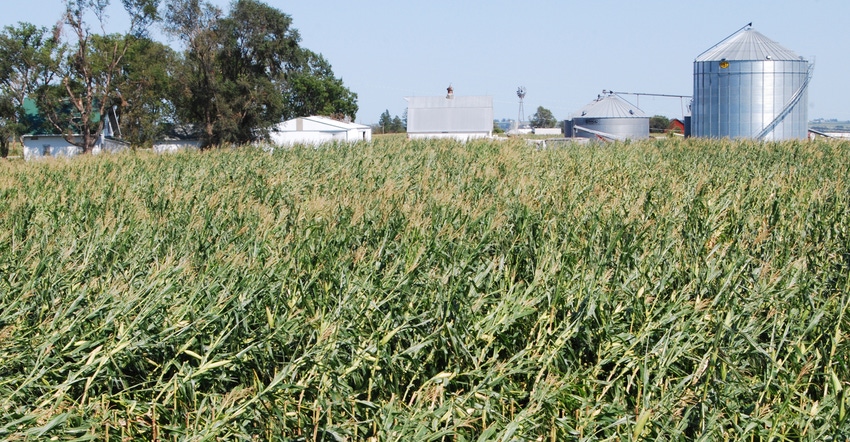August 24, 2020

With many fields suffering wind damage and corn yields also crippled by drought, more farmers than usual will be making silage rather than harvesting corn for grain this fall. The increased amount of silage harvested will exceed the current silage storage capacity on many farms.
“Before harvesting corn for silage, be sure you have a market for the silage or a sufficient number of livestock to feed it to,” says Brian Dougherty, Iowa State University Extension ag engineering specialist. “It may be difficult to harvest good-quality corn silage if the crop has weather damage and the economic value of the silage will likely be lower than silage from non-damaged fields.”
The resources section at the end of this article has links to information to help with pricing forages in the field and determining the economic value of corn silage. Dougherty provides the following tips for harvesting and storage.
When harvesting lodged corn for silage, use a Kemper head if possible. If a row crop head is used, flattening the head angle may help with feeding lodged corn into the forage harvester. Harvesting against the direction in which the crop is leaning and running the head as close to the ground as possible can also help.
In situations where immature or drought-stressed corn is being harvested, there is potential for high nitrate concentrations in the silage. High nitrate levels can be managed by increasing the cutting height or by diluting it in the feed ration. If high nitrate concentrations are a concern, submit a sample to a forage testing lab before the silage is fed to livestock.
Storage options for silage
The keys to good silage storability are harvesting at correct moisture, achieving good packing density, properly installing and maintaining silage covers, and selecting a good location for storage. With unplanned silage harvest, flexible storage alternatives are needed, Dougherty says. These can include:
Silage bags. Bags are a good option for storing silage. They allow for flexibility in both storage capacity and location. The preferred moisture range for bagged corn silage is 60% to 70%. Exceeding 70% moisture may lead to seepage, nutrient loss and spoilage. Bagging silage too dry can cause uneven packing and lead to poor fermentation. Bags should be inspected regularly for holes and repaired immediately with bag tape if damage occurs. Placing bags away from trees and mowing vegetation around the bag can help prevent damage from animals.
Drive-over piles. This is a relatively inexpensive option for storing large volumes of silage. A moisture range of 65% to 72% works well for corn silage in drive-over piles. The key to making quality silage in piles is achieving good packing density. Spoilage losses can exceed 30% in poorly constructed piles. Unpacked piles are not an economical storage option. Silage should be placed in 6-inch layers and thoroughly packed with heavy machinery equipped with a front-end loader or push blade.
You can multiply the estimated tons per hour delivered to the bunker by 800 to get the pounds of packing weight needed. Pile slopes should be no greater than 3:1 to minimize risk of equipment rollover during filling. Use tractors equipped with rollover protection and seat belts for packing. Piles shouldn’t be higher than the feedout equipment can safely reach. Excessive pile height leads to silage overhang and potential collapse of the silage face. This is a serious safety hazard that may lead to injury or death.
High-capacity forage harvesting equipment and sufficient packing capacity is needed to make large piles quickly. Ideally, piles should be built and covered the same day to avoid spoilage losses from the exposed silage surface. The pile should be covered with plastic and sealed along the sides by piling soil or other heavy fill material on top of the plastic. Tires, sandbags or other weights that won’t puncture the surface can be used to secure the plastic.
Poorly secured plastic will lead to spoilage and is subject to wind damage. Rope can be stretched between weights to help secure the plastic if there aren’t enough weights to cover the entire surface. Leaving the pile uncovered will result in substantial spoilage losses that likely exceed the cost of purchasing and installing a cover. More information on pile sizing, construction and feedout techniques can be found in the online resources listed at the end of this article.
Trench silos. An alternative to piles is a trench design. In areas with suitable topography, short sidewalls can be constructed by excavating into a hillside. Sidewalls should be sloped outward from the bottom and height should be kept to a minimum. Walls should never be excavated vertically as this can lead to sidewall collapse. Lining the sides with plastic before filling will reduce spoilage losses and improve feed quality.
Sidewalls must be able to withstand lateral forces from both silage and packing equipment. Attempting to construct temporary bunker sidewalls out of round bales or other unsecured materials isn’t recommended. Unsecured or poorly engineered walls are a serious safety hazard that can fail rapidly and lead to equipment rollover.
Site selection and preparation
Good site preparation is critical for reducing spoilage and feedout losses. Select a location that allows water to drain away from the site. Don’t locate bags or piles in a low area that may become inaccessible during wet conditions. Digging a shallow trench around the upslope area can help to divert surface water away from the site. A well-packed pad constructed with a 6-inch layer of 1.5- to 2.5-inch-diameter gravel under a 3-inch layer of limestone screenings makes an acceptable base for year-round access.
For temporary storage, placing bags or piles in a field or grass area is an option. However, equipment traffic during pile feedout on a site without a constructed base is likely to create ruts and mudholes during wet weather. Feeding out during cold weather can help, but the ground underneath piles will not freeze and may turn to mud. Investing time into site selection and preparation will help make temporary storage a success.
Resources for making silage decisions include:
Determining the economic value of corn silage
Ag Decision Maker: Pricing forages in the field
More information on making quality corn silage
Recommendations for managing forage in silo bags
Information on drive-over silage pile construction
Disaster Recovery: Managing immature crops for grain or silage
About the Author(s)
You May Also Like






